What’s The Healthiest Cookware to Use?
One of the most common questions that my clients ask is what the healthiest cookware to use is? We all hate having to scrub the stainless steel pans and enjoy the ease of use of the non-stick technology. But are non-stick surfaces dangerous for our health? What would be the best alternative?
The scientific advancement of discovering non-stick cookware decades ago quickly became the dream of many home cooks and chefs alike. The material is easy to use and easy to clean leaving little not to like about the material.
Unfortunately, the latest 20 years of research has identified non-stick surfaces as a major human health hazard. Toxic vapors and poisonous substances are inherent dangers of non-stick cookware. (1, 2)
Without adequate safety testing, non-stick cookware was approved by the government in 1960. At the time, there was no specific safety regulations for approving such cookware. The chemicals found in Teflon were also considered safe during the time period. These substances were found in fried hamburger meat and did not cause a major public health scare.
Non-Stick Coating Toxicity:
DuPont, the original company that learned the use of these chemicals to create non-stick cookware claimed over 50 years that their product did not emit toxic chemicals through normal use.
Recently DuPont even claimed that “significant decomposition of the coating will occur only temperatures exceed above 660 degrees F (340 degrees D). These temperatures are well above normal cooking range.”
Recent testing has observed that a non-stick frying pan reached 736 degrees F in only 3 minutes and 20 seconds. This testing heated a pan on a conventional, electric stovetop burner and the temperatures continued to climb until testing stopped. This brand of Teflon reached 721 degrees at 5 minutes (3).
According to research by DuPont, Teflon emits hazardous chemicals at 446ᴼF. The release of at least 6 highly toxic gases is evident at 680ᴼF. Temperatures of 1,000ᴼF reached using stovetop drip pans produces even stronger chemical leaks.
At these temperatures non-stick coating is broken down into the chemical warfare agent, PFIB. PFIB is comparable to the nerve gas phosgene used during WWII.
Toxins in Non-Stick Cookware:
The chemical known as PFOA (perfluorooctanoate) has received special attention by the EPA in recent years. Despite the release of many other harmful substances, PFOA is the only perfluorinated toxin found in non-stick coatings.
PFOAs are found in food packages, personal care products, upholstery and of course Teflon non-stick coatings. Other products containing this chemical are:
- Nail polish remover
- Eyeglasses
- Repellant agents for soil, grease, and water. For instance carpet and furniture care treatments.
- “No-iron” and “wrinkle-free” clothing
- Microwave popcorn non-stick food wraps
- Pizza boxes
- Leather, shoe and clothing protective sprays
- Paint
- Cleaning products
In microwavable popcorn, the FDA found that the PFOA contaminates the oil and migrates to the popcorn during the heating process- ultimately available for human consumption. Researchers estimate that 95% of Americans have PFOA in their blood (4).
Jane Houlihan, vice president and activist for research at the Environmental Working Group, summed up this health costly mistake made by the chemical industry. She stated, “And how could they not be in our blood? They’re in such a huge range of consumer products.”
Non-Stick Coating Dangers
Animal studies have linked the chemical to numerous health risks including: (5, 7, 8)
- Reproductive disturbances such as infertility and birth defects
- Immune system complications
- Alterations to regulating thyroid hormones
- Liver, pancreatic, mammary and testicular gland tumors
These risk are noted by the EPA and warn that PFOA also poses a serious threat to the development and reproductive abilities of humans.
DuPont was accused by the EPA of failing to report crucial health information regarding the use of PFOA back in 1981 and were labeled liars. DuPont finalized a settlement back in 2005 with federal officials and was fined more than $313 million for withholding the deleterious health effects of PFOA (9).
The EPA suggested DuPont’s withdrawal of Teflon from the marketplace by 2015. DuPont continues to assert that Teflon products are completely safe. Fortunately, some big restaurant supplies retailers are moving away from these non-stick products.
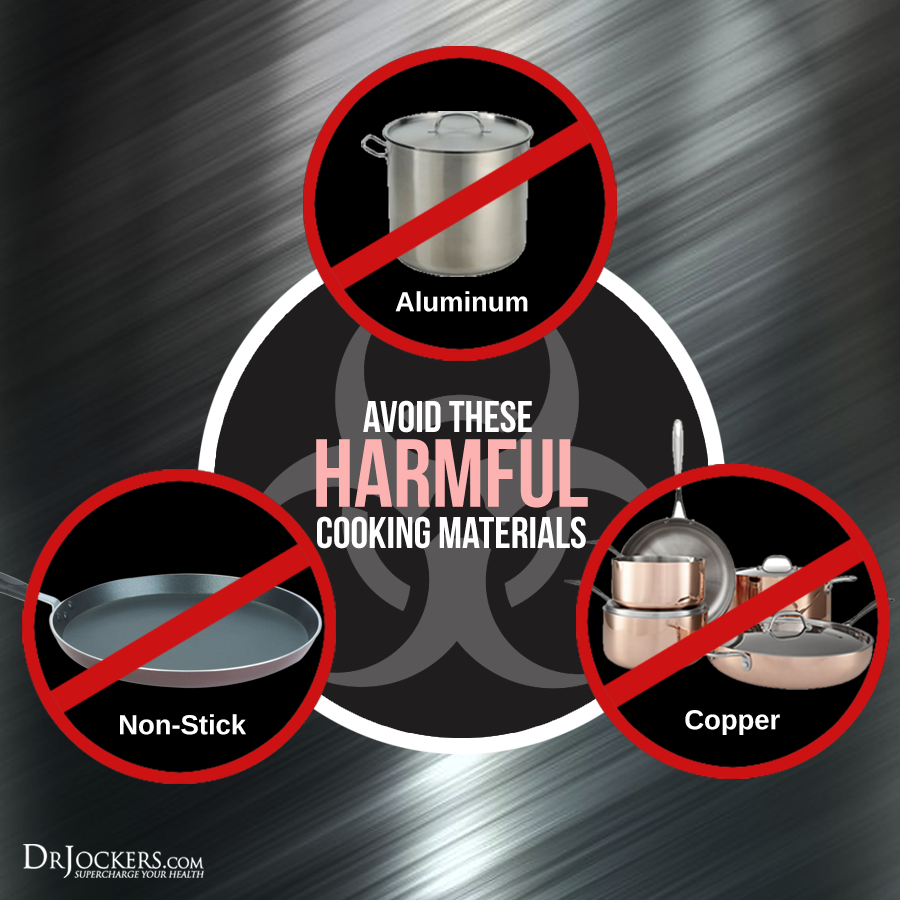
Avoid these Harmful Cooking Materials:
Aluminum:
Preventing your exposure to aluminum today is impossible but you can limit your risk of its consumption when cooking. The link between individuals with kidney stones as well as Alzheimer’s disease with high aluminum concentrations has been consistently noted.
Yet scientists have been unable to definitively determine if aluminum alone is responsible for such harmful causes. Bearing these risks in mind, aluminum is already concentrated in antacids, deodorants, aspirin, food additives, flour, baking powder and cosmetics. (12)
Some sources of aluminum cookware have even been found to contribute to lead poisoning in developing countries (13). If replacing your cookware with healthier materials is not affordable to you now, one study found that first boiling water in an aluminum pot or pan can reduce the transfer of harmful agents by up to 60% (14).
Copper:
The CDC’s Agency for Toxic Substances & Disease Registry suggest that although a common metal found in the air, water and environment around us, our daily exposure may already be high.
The acceptable standard for drinking water is 1,300 ppb. Combined with corrosive copper pipes and environmental contamination, most households have drinking water with more than 1,000 ppb. (6, 16)
Overexposure to copper has been associated with adverse respiratory effects, gastrointestinal upset such as nausea and diarrhea, abnormal blood cell counts, Cushing’s syndrome, and other systemic symptoms such as headache, muscle aches, drowsiness and fever. (16)
Copper cookware is an excellent conductor of heat providing evenly controlled temperatures when cooking. However, the safety concerns involving copper should have you ditching copper along with your non-stick pots, pans and baking products.
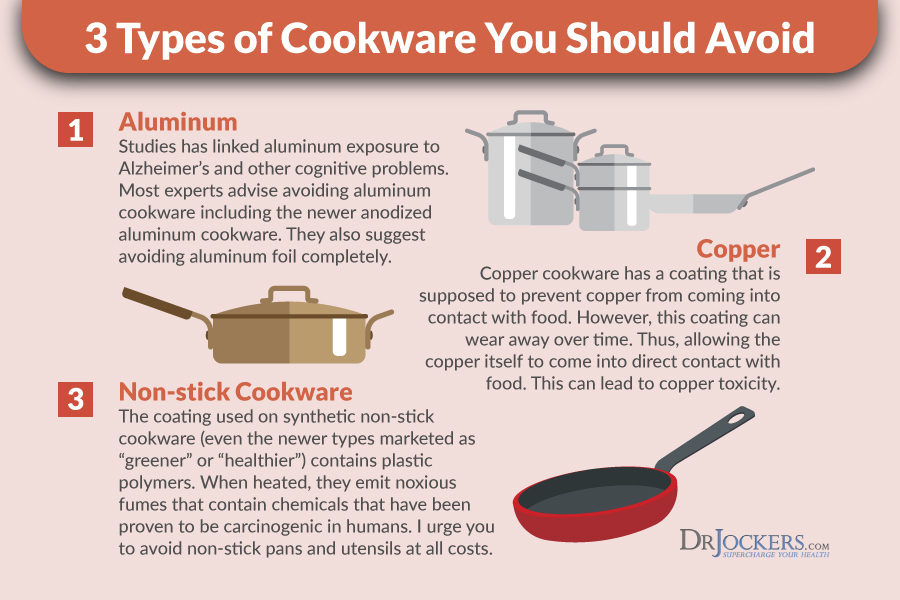
Ditch Non-Stick Cookware Now:
There are many healthier alternatives for safe cookware on the market today. Ceramic, stainless steel, cast iron and glass are excellent options. With any product, if any cookware is damaged via cuts, chips or any sort of abrasion the product should not be used.
Stainless steel is highly regarded as safe because it is generally inert. However even stainless steel can leach metals into food including nickel, chromium and molybdenum. Fortunately, many options are available to you depending on your cooking purpose. So what is the healthiest cookware on the market?
Stainless Steel:
As mentioned, stainless steel cookware is some of the best type of material to cook with because it is generally not reactive with foods. Stainless steel however is not the best conductor of heat and often you will find products that have a copper or aluminum coating on the bottom of the pan to improve heat transfer.
Stainless steel products may also come with an interior layer of aluminum or copper (6). Any damages to the cooking surface will increase the risk of heavy metals leaching into your food. Although they are unlikely to stain, dent and are relatively resistant to scratches, stainless steel like any other product should be discarded if there are any damages to the material.
Cons of Cooking with Stainless Steel:
Despite the benefiting factors that support cooking with stainless steel, this material does have potential health risks. Studies have found that when tested amongst other types of commercial cookware, stainless steel released the highest concentration of nickel into food when subjected to high temperatures.
There is also evidence indicating that stainless steel releases chromium and small quantities of iron as well. (10, 11) Depending on the grade of stainless steel, cooking with acidic foods such as vinegar, white wine, tomatoes and citrus fruits can promote this metallic contamination.
While many past studies that have tested the safety of stainless steel in food production have not detected heavy metal contamination, these studies used foods that did not contain acetic acid. (11) When cooking with foods like lemons and tomato paste it may be best for you to choose glass cookware to reduce your exposure to heavy metals.
Nickel can trigger systemic allergy symptoms such as dermatitis. Individuals with chronic-allergic dermatitis may opt to avoid cooking with stainless steel all together (10).
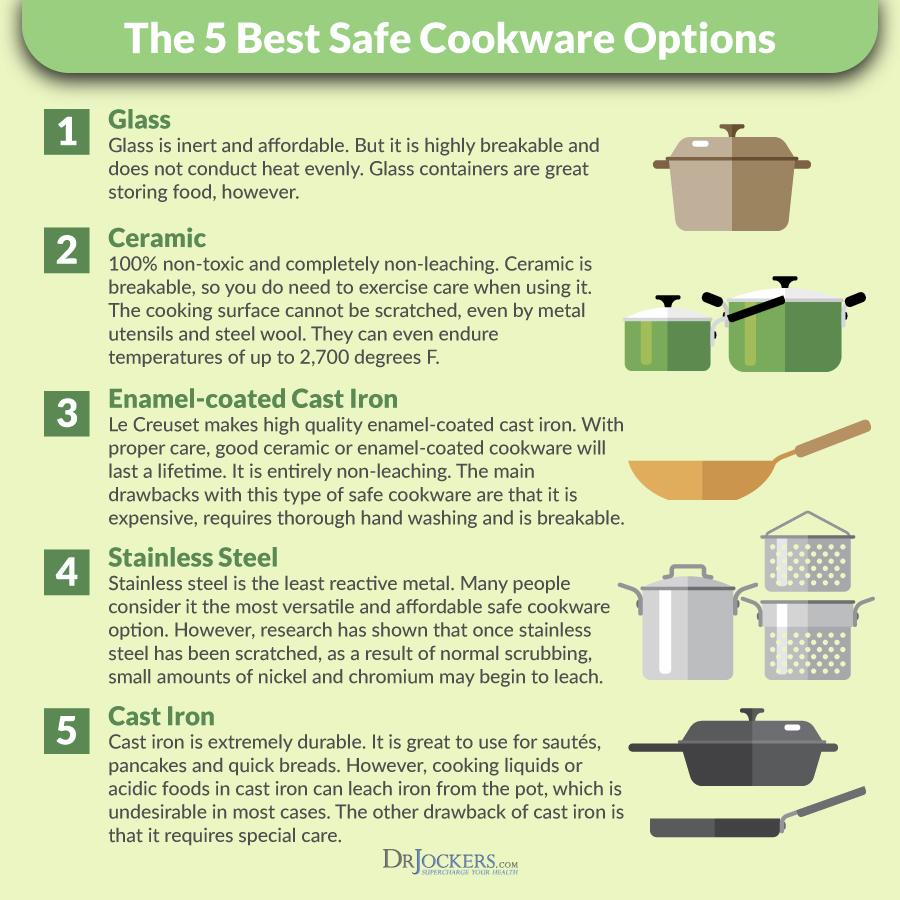
Cast Iron:
Cast iron is a generationally approved cookware that may have more history with your family than you know. Unless you suffer from having high amounts of iron, this cookware material is top rated amongst many cooks (6).
Cast iron is easy to maintain, can be purchased already pre-seasoned and is most enjoyed to develop a sear on foods. Regular cast iron can also react with acidic foods producing a metallic flavored or discolored product.
If you plan on simmering a homemade spaghetti sauce throughout the day, consider enameled cast iron. This is a good one here
Although this cookware can be incredibly expensive, enameled cast iron has all the benefits of cast iron including a high heat retention property and will not contribute a metallic taste or food discoloration throughout the heating process.
Ceramic:
Another worthy option first evident due to its high expense is ceramic. Comparable to enameled cast iron, ceramic retains high temperatures for extended periods of time without the threat of toxic fumes or heavy metal leaching into food.
The material is easy to cook with and easy to clean. Ceramic products are produced with inert minerals, are non-toxic, non-reactive and do not discolor or change the taste of the prepared food (3, 15). Some suspicion has been raised regarding the safety of glazed or non-stick coating ceramic on the market.
It is best to do your research regarding each manufacturer and the quality of materials and safety guidelines and reports available to you, the consumer. Here is a very good one that is available.
Glass:
The pros of glass cookware far outreach its disadvantages. Cooking with glass ensures that any food you prepare will not cause a reaction with the cooking material. Tempered glass that is produced for high temperature cooking and baking offers the best durability but you should also be sure to purchase products that are lead-free.
When cooking with glass, be sure to follow product recommendations as one con to cooking with glass is its likelihood to shatter. Most manufactures warn against introducing cooled glass to direct, high temperature surfaces.
Glass may be produced with other materials such as ceramic but the material will never absorb food odors or flavors. Cooking with glass also provides the additional benefit of placing leftover foods directly into the fridge for safe storage. Here is a good set to get.
What I Recommend:
I recommend to my clients the use of glass cookware whenever possible. Of course, glass pan skillets are currently not available. I prefer the use of these glass pots here and the Green Earth skillet that is PFOA and PTFE free. Without PFOA and PTFE chemicals, the non-stick surface doesn’t last longer than a year.
For this reason having high quality stainless steel pans is a great. 360 Cookware has extremely durable quality. Try most cooking using glass and rotate in Green Earth products and stainless steel cookware when needed for easier maintenance.



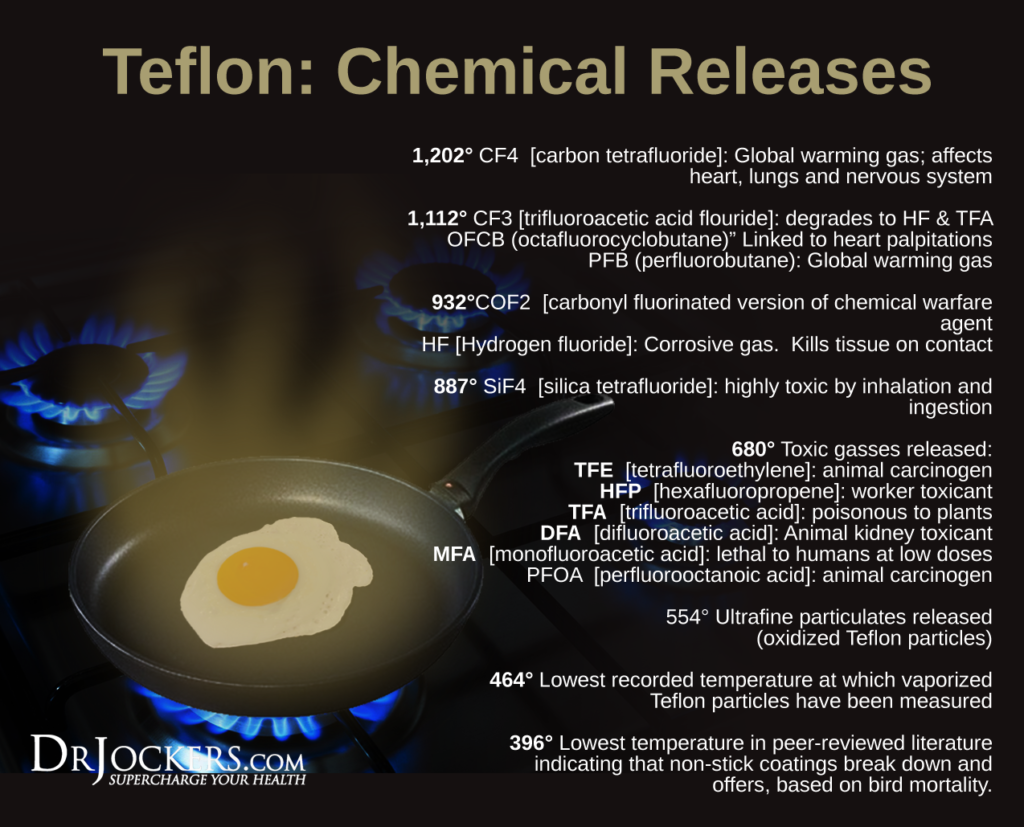
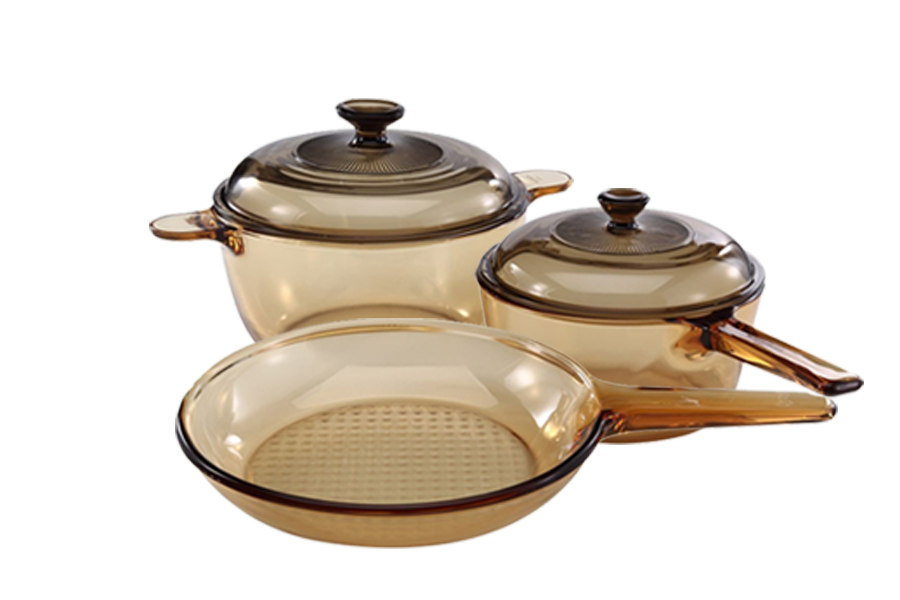
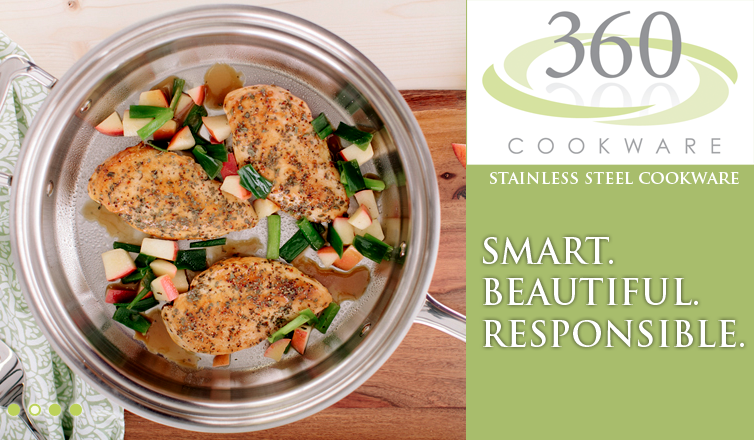



DR. Jockers, you’ve GOT to research TOWNECRAFT cookware, go to cooksavour.com. It’s surgical stainless steal, ablute safest you can get, no doubt!
Thanks Brennan, we will check it out!
Is silicone bake-ware harmful to use?
The cooksavour site is down. It’s transferred to murderinthekitchen.com
Thanks for sharing JaRee!
Friendly greetings.
What is your opinion about carbon steel wok?
Thank you for your time to reply.
I’m not sure George, I haven’t heard of this one!
This article is completely contradicts itself. There as a large graphic, it says Avoid These Harmless Cooking Materials: NO STAINLESS STEEL, NO CAST IRON.
Then it says the exact opposite:
Cast Iron:
Cast iron is a generationally approved cookware that may have more history with your family than you know. Unless you suffer from having high amounts of iron, this cookware material is top rated amongst many cooks (6).
Stainless Steel:
As mentioned, stainless steel cookware is some of the best type of material to cook with because it is generally not reactive with foods.
Due to this I don’t trust anything in it.
Hey Shanna, stainless steel and cast iron are better than copper and aluminum, however they are still not the best choices. Glass and ceramic are the better options as I mentioned. I hope that helps clear things up!
I ordered a pot from Xtrema which is a company that produces high quality ceramic, however, unfortunately it failed the baking-soda test. I boilded water with 1 scoop of baking soda for 5 minutes and let it cool off. When I tasted it, it was very bitter and different than what the baking soda in the glass of water tasted like BEFORE I conducted the test. Any advice?
Hey Shawn, My favorite type of cookware is glass!
On this page, you say baking soda contains aluminum: “Bearing these risks in mind, aluminum is already concentrated in antacids, deodorants, aspirin, food additives, flour, baking soda and cosmetics. (12) ” When I clicked on the “baking soda” link, the next page said this: “Contrary to popular opinion, baking soda does not contain aluminum but baking powder which is a different product may contain aluminum. So there is no need to buy “aluminum-free” baking soda but you would definitely want to purchase “aluminum-free” baking powder if you are going to use that for baking.” I googled “baking soda” to see if it contains aluminum, and it does not. Because you celebrate all of the benefits of using baking soda, why would you do that if it contains aluminum? I think that more careful proofreading of your articles is in order.
Yes this is an incorrect statement and we will change it. Thanks Gabriella!
Where can I buy glass clear glass cookware that’s not tinted like the Pyrex in the US
What is the safest brand for a ceramic skillet?
This one has good reviews Rhonda: https://amzn.to/2Shelb3
I like to oven bake chicken breasts.. And I like cook roasts in the oven..
Should I be using glass cookware to cook meat in the oven?
Are we talking about pyrex?
Yes glass is very good to use!
Once you’ve had glass cookware and bakeware explode on you, you’ll never use it again. I’ve been cooking for 46 years and products aren’t made like they used to be. Pyrex shattering is a much more common occurrence than ever before.
What I’ve learned is that cookware all comes down to personal opinion and experience. There is no such thing as “best” anymore. Even experts are simply giving their opinions based on their own experiences (and even more likely today, for profit).
I have come across 316 titanium cookware (salad master series) have you any comments on this?
Yes salad master is excellent and I use it myself!
I love to cook, so I’ve been looking for better cookware. I am asking for a new set of cookware for Christmas. This article was very helpful in deciding what to put on my list! Thank you! 🙂
That is great to hear Suzie! I am glad it helped!
We saw the movie DARK WATERS 2 nights ago about PFOA and its sister chemicals. DuPont DOW Monsanto etc are criminal organizations in love with their money. They are killing everyone and everything with their “better living through Chemistry” with the help of our government. The Movie is the true story of how DuPont knowingly has poisoned us with PFOA. They lost a 670 million dollar class action law suit and this crap is still used everywhere. Get the carpet out of your house, don’t buy anything that is new. Shop in resale shops for the 1950’s and before furniture/rugs made of wool. BE CAREFUL what you bring into your home, put on your body and in your body. BE CAREFuL. Invest in Airfilters, waterfilters, you are eating and breathing this stuff……..
Thank you Dr J. You are so VERY Loved and Appreciated here!
Yes very important to clean up your environment Maggie! Blessings to you!
Hi Dr. Jockers. I am trying to find alternative cooking pots for my weekly meal prep. I need at least an 8 quart pot. I don’t see any glass pots this large. What should my 2nd choice be, ceramic or stainless steel? Is the stainless tri ply ok with the aluminum heat transfer layer so long as the inside of the pot does not get damaged? I’m trying to find an affordable & safe solution. Thanks, Chris
I would look for ceramic!
Would it be a ‘ceramic coated’ stock pot? I’m having a difficult time finding one. Many of the ones that are coming up online say ‘ceramic coated’ on the inside. I’m not sure if that’s how they come, or if it’s supposed to be 100% made out of ceramic?
Yes that will work Chris!
What would be your recommendation for an electric tea kettle ?
What material is safest/ healthiest?
Stainless or glass?
And country origin/manufacture
I would do stainless steel if possible. I don’t believe they make them in glass. Ideally USA made! This is a good one https://amzn.to/2x3pKWy
This doesnt have anything to do with cookware- but what are your thoughts
with compounded hormones for ladies experiencing menopause?
What medical degree is your doctorate in?
Thank you
Sheryl
Hey Sheryl, compounded hormones have a place but we prefer to work on balancing the stress response. Dr Jockers is a Doctor of Natural Medicine and a Doctor of Chiropractic
Your link under Ceramic goes to Amazon cookware w/aluminum. It doesn’t look like it has a ceramic cook surface.